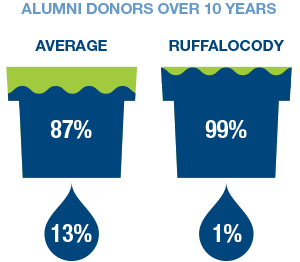fundraising
The Reports of Phonathon’s Death Have Been Greatly Exaggerated
 Phonathon is not dead.
Phonathon is not dead.
We’ve all been talking about the declining number of donors to higher education, influenced by both a “leaky bucket” of alumni donor loyalty decline and the fact that so many of our youngest alumni are not yet contributing. We were wondering how institutions that have comprehensive phonathon programs compared to the national trends.
So, we went through the Voluntary Support of Education database and created some comparison groups. Here’s what we found:
In 2013, all higher education institutions averaged 87% of their total alumni donors from 2003.
Institutions with RuffaloCODY on-site managed phonathons averaged 99% of their 2003 alumni donor total.

At some institutions, this amounts to thousands of donors and certainly affects both dollars and the alumni participation figures used for rankings. It’s great to see that even through a major recession, there is evidence that programs committed to a comprehensive phonathon have retained a strong donor base. As the economy improves, we’re all hoping that we can see the alumni donor numbers return to their peak from 2007.
If it’s so much harder to reach alumni, why have schools with comprehensive phonathons retained their donor base through the recession?
First off, there’s nothing like sitting in a room and having a great group of students dial away through your entire donor pool and make the case for support. The fact that phonathon programs take gifts via debit and credit card right there on the spot certainly helps encourage donor action in a time when first class mail use is declining. These institutions are also very likely to have comprehensive multi-channel annual fund programs, allowing donors to respond to the channel they most prefer.
The influences on the donor pool are also greater than the actual phone solicitation. In an age of data overload, phonathon is a powerful focused data enrichment tool. A comprehensive phoning program calls through a big part of your database, making updates, confirming employers and addresses. This helps solicitations through other channels like direct mail and email, including being able to send everyone you spoke to a link to your online giving page. This valuable information is also crucial for prospect research in the major and planned gift program.
We heard earlier this year from the Non-Profit Research Collaborative that organizations with solid annual funds are more likely to be on track with their overall fundraising goals, and this is not surprising. There is a huge synergy between annual and major/planned gifts.
There is also a deeper influence at the basic level of what psychologists call “normative behavior.” Phoning programs involve a person (usually a student) asking another person to contribute.
Institutions with strong annual fund and phonathon programs have alumni that are used to being asked.
And when we call, a whole bunch of them say: “Yes.”